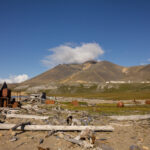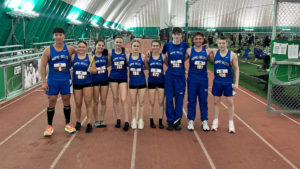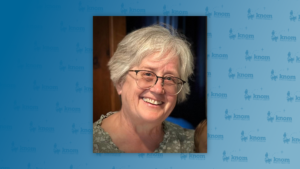The region that your support allows KNOM to serve — the rural stretches of Western Alaska — is as vibrant as it is massive, as fascinating as it is remote. Nothing conveys these extremes more than the trips that our volunteers so often take to the isolated villages of KNOM’s AM listening area.
We’re happy to report that, in late August, four of our newly arrived volunteers — Caitlin Whyte, Francesca Fenzi (pictured), Jenn Ruckel, and Courtney Cousins — were able to spend time in the village of Wales. It’s one of the westernmost inhabited places in North America, a place where, on a clear day, you can see the easternmost coastlines of Russia (faintly visible near the horizon in the top photos). Thanks to a sponsorship arrangement with a regional airline, the airfare for this special trip, like almost all of our village travel, was completely free.

Our volunteers’ primary reason for making the journey to Wales — about an hour’s plane ride northwest from Nome — was to attend the Kingikmiut (KING-ick-myoot) Dance Festival, a beloved annual gathering of traditional Alaska Native music and dance ensembles from throughout our region. Per usual, Kingikmiut 2014 was a rich experience and a chance for our crew to record music and gather materials for potential radio productions. Regarding the festival’s dance performances (such as the one pictured), volunteer news reporter Francesca says she was in awe of “how expressive even the smallest gestures can be” and of the “nuance of emotion” conveyed by the festival’s most honored participants — the community elders. But, she also points out, it’s an event for young and old alike: a “multi-generational thing.”

Even outside the confines of the festival, our volunteers had ample opportunity to learn more about Alaska Native culture. They learned to make Alaskan kuspuks, garments somewhat similar to a hooded sweatshirt (but with thinner, colorful cotton calico), by spending time with a visiting teacher at the Wales school. Pictured is Caitlin working on her own kuspuk, which she prepared in the traditional way: by measuring the fabric against her own body frame and then ripping the fabric by hand. A few of our volunteers even got to meet Maligiaq (muh-LEE-gee-ack), an expert builder of traditional kayaks who happened to be visiting Wales from his native Greenland and was (carefully) building a kayak throughout the weekend.

Finally, Francesca and Caitlin also had the opportunity to travel to Tin City (pictured below), another coastal community a short distance past Wales. It’s a remote, largely abandoned site with a still-active military base that, during the Cold War, would have been one of America’s closest points of contact with the Soviet Union. In Tin City, where less than 20 people still live, Francesca and Caitlin were able to explore sections of the military installation that are now abandoned, such as the massive, defunct microwave link towering over Caitlin below. (Very similar, Cold-War-era communications towers are still standing in Nome, as well.) This visit is just a reminder of the unique position that rural Alaska once had — and still holds — in America’s larger involvement in the Arctic.
As always, we can’t thank you enough for making possible trips like these. They introduce our volunteers to the incredible region we serve — and vice versa — and are a source of vitality for our mission. Thanks so much.







